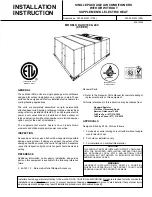
System Performance with Advanced Microprocessor Controls
33
A suggested tuning procedure is as follows:
1. Initially adjust the integral and derivative settings to 0%/ degree-min and 0% /degree/min.
2. Starting with 20% /degree, adjust the proportional setting in small increments (10% steps) until
the control sustains a constant hunting action (the temperature swings are approximately the
same amplitude from one peak to the next).
3. Note the time in minutes between peaks of adjacent temperature swings and the amplitude of the
temperature swing (degrees above the setpoint).
4. Adjust the proportional control setting to about 1/2 the value obtained in
Step 2
.
5. Adjust the integral setting to a value calculated by the following equation:
Adjust the derivative to a value calculated by the following equation:
time between peaks x 5%
The above tuning procedure is only an approximation for an initial set of adjustments and are based
on the “average” room characteristics. Your particular settings may need to be further adjusted for
optimum PID control performance. Some suggestions for additional tuning are as follows:
• If cooling output overshoot is occurring on load changes, decrease the proportional setting or the
derivative setting.
• If system hunting occurs with constant room load, decrease the integral setting.
• If the control responds too slowly, resulting in large temperature excursions on a load change,
increase the proportional setting or the derivative setting.
• If a constant temperature deviation exists between the temperature and setpoint, increase the
integral setting.
4.3.3 Intelligent Control (Chilled Water only)
The intelligent control operates from a set of general rules that define how the control output should
be adjusted for different system conditions. The rules are designed to duplicate the actions that an
experienced human operator would take if manually controlling the system.
Just as an operator might take several things into consideration before making a temperature control
decision, the intelligent control can be programmed to do likewise. For example, not only is the cur-
rent temperature used in making temperature control decisions, but also conditions such as:
• How fast is the temperature changing?
• What direction is the temperature changing?
• What is the cooling output now?
• What was the cooling output in the past?
• How long ago was the cooling output changed?
• and other factors.
Any number of rules can be used in an intelligent control to define the controls operation under vari-
ous operating conditions. Hence, several advantages are gained from this type of control over a more
standard control approach that uses a fixed mathematical equation to define the operation of the con-
trol for all conditions (such as a proportional or PID control). You can expect intelligent control to be
more efficient and precise for most applications, but system performance based on room conditions is
not as predictable as standard approaches that use a fixed equation.
NOTE
If this calculation results in a value of less than 1%, then set the integral to 1%.
Approximate room load (in % full load)
Time between peaks x peak amplitude x 4
Содержание CHALLENGER 3000
Страница 2: ......
Страница 8: ...vi ...
Страница 74: ...Semiannual Maintenance Inspection Checklist 66 ...
Страница 75: ......
















































